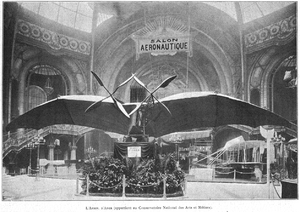Avion III
The Avion III (Avion № 3 a.k.a. Aquilon, the Roman wind god) was an airplane designed on Clément Ader following his Éole and Avion II. He designed it in the 1890s under contract with the French military.


The airplane did not preform as well as expected when demonstrated in 1897, and the commissioners responsible for evaluating it were unimpressed.
The government of France spent 300,000 francs over five years backing development of Avion III', in addition to Ader's own expenditures.[1]
Zahm writes the following about Avion III:
In truth Avion No. 3 was hardly, if at all, excelled in airframe design by the first prize-winner planes of Santos-Dumont, Farman and some others. Ader's state contract required at least 6 hours nonstop flight with two men aboard, at any altitude up to "several hundred" meters! The dauntless and resourceful inventor expected to fulfill that requirement. For some months he had bench tested the whole propulsive plant, "running entire days." The wings had been structure-tested under full load, distributed as in normal flight. Doubtless his engine could run all day if duly supplied with steam. The plane, with its quaint three-torque control, might operate safely in calm weather, hereby ensuring immense enthusiasm and support. Says Ader in his book dated December, 1906, p. 24: "Avec un conducteur exercé, l'avion serait resté dans l'air autant de temps que sa provision de combustible l'aurait permis, c'est-a-dire plusiers heures."
One may add that in 1898 Ader presented his repaired and well improved Avion No. 3 to the Conservatory of Arts and Measures, where it was displayed with outspread wings, near the engine of Eole No. 2. Plans for the steam plant, engine and propeller he sent to the War Ministry. All else he kept till July, 1903, then destroyed; the Eole, the copious designs and records, the entire laboratory and equipment.[1]
(Zahm explains in a footnote that the Avion III, with wheels added and screws modified following trials in 1897, was displayed at the 1908 Aeronautic Exposition in Paris.)[1]
Links
References
- ↑ 1.0 1.1 1.2 Zahm, 1944, pp. 340–344.
